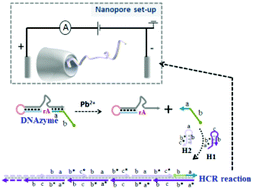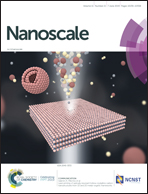An investigation of solid-state nanopores on label-free metal-ion signalling via the transition of RNA-cleavage DNAzyme and the hybridization chain reaction†
Abstract
Recent advances have proven solid-state nanopores as a powerful analysis platform that enables label-free and separation-free single-molecule analysis. However, the relatively low resolution still limits its application because many chemicals or targets with small sizes could not be recognized in a label-free condition. In this paper, we provide a possible solution that uses solid-state nanopores for small species signaling via the transition of huge DNA assembly products. DNAzyme responding to metal ions and the hybridization chain reaction (HCR) generating nanopore-detectable dsDNA concatamers are used as the transition model set. By the two-step DNAzyme-HCR transition, Pb2+ that was too tiny to be sensed was successfully recognized by the nanopore. The whole process happened in a completely homogeneous solution without any chemical modification. During condition optimization, we also discussed one possible application challenge that may affect the HCR signal-background distinction. Solid-state nanopores provide a potential solution to this challenge due to its ability to profile product length or even 3D structure information.



 Please wait while we load your content...
Please wait while we load your content...